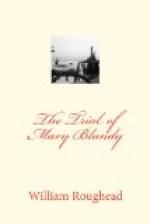Footnotes:
[1] Henry Bathurst (1714-1794), Solicitor-General to the Prince of Wales, 1745; Judge of the Court of Common Pleas, 1751; Lord Chancellor, 1771; succeeded his father as Earl Bathurst, 1775; and in the following year presided as Lord High Steward at the trial of the Duchess of Kingston. He resigned the Seal in 1778.—ED.
[2] This quotation is the only reference made during the trial to this important letter, which, from the report, does not appear to have been formally “put in.” See Introduction.—ED.
[3] So far as appears from the report of the trial, no proof was offered that these words were in the handwriting of Cranstoun. See Introduction.—ED.
[4] The Earl of Macclesfield and Lord Cadogan, the local magistrates who undertook the preliminary work of getting up the case for the prosecution.—ED.
[5] Afterwards Sir Richard Aston, and one of the Commissioners of the Great Seal on the death of Lord Chancellor Yorke in 1770.—ED.
[6] Born, 1713; died, 1790. Practised as a physician at Reading until 1754, when he removed to London. Chatham was one of his patients. As a specialist in mental diseases he was called in to attend George III. in 1788. He was the father of Henry Addington, first Viscount Sidmouth.—ED.
[7] The doctor intended to have excepted the stone found in Mr. Blandy’s gall-bladder.—Original Note.
[8] Born, 1714; died, 1781. Practised in London till 1745, when he removed to Kingston-on-Thames. He was eminent for his writings on the Pharmacopoaeia.—ED.
[9] Saturday. See infra.—ED.
[10] This lady was Mary Blandy’s godmother. She died in 1781 at the age of 86. It is remarkable that the prisoner’s fortitude remained unshaken throughout the trial except when Mrs. Mounteney was in the box.—ED.
[11] The counsel for the prisoner waived the objection to this as hearsay evidence, because the counsel for the Crown assured them they would call Betty Binfield herself next.—Original Note.
[12] According to the practice then in use, counsel for the defence were not permitted to address the jury.—ED.
[13] Heneage Legge (1703-1759), second son of William, first Earl of Dartmouth, was called to the Bar, 1728, took silk in 1739, and was appointed one of the Barons of Exchequer in 1747.—ED.
[14] The celebrated Catherine Hayes, heroine of the Newgate Calendar and Thackeray’s Catherine.—ED.
[15] George Carre of Nisbet, son of John Carre of Cavers, admitted Advocate 9th June, 1752. He became Sheriff of Berwick in 1748, and wasraised to the Bench as Lord Nisbet, 31st July, 1755. He died at Edinburgh, 21st February, 1760.—ED.
[16] Charles Erskine, Lord Tinwald.—ED.
[17] George Parker, second Earl of Macclesfield, son of Lord Chancellor Macclesfield, was a famous philosopher and President of the Royal Society. He had the principal share in preparing the Act of Parliament for the introduction of the change in the Calendar in 1751, known as the “New Style.”—ED.




